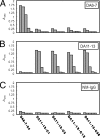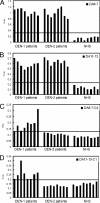Generation and characterization of monoclonal antibodies against dengue virus type 1 for epitope mapping and serological detection by epitope-based peptide antigens
- PMID: 17287314
- PMCID: PMC1865613
- DOI: 10.1128/CVI.00249-06
Generation and characterization of monoclonal antibodies against dengue virus type 1 for epitope mapping and serological detection by epitope-based peptide antigens
Abstract
Dengue virus (DEN), the pathogen behind dengue hemorrhagic fever, remains a public health problem in Asia and South America. In this study, monoclonal antibodies (MAbs) against DEN serotype 1 (DEN-1) were generated by fusing NSI/1-Ag4-1 mouse myeloma cells with lymphocytes from BALB/c mice immunized with DEN-1. Twelve MAbs were found to react specifically to the DENs by enzyme-linked immunosorbent assay, immunofluorescence analysis, and immunoblotting analysis. Five MAbs, namely, DA4-7, DA6-7, DA9-5, DA10-2, and DA11-13, were found to react with envelope proteins of DEN-1. Two serotype-specific MAbs of DEN-1, DA6-7 and DA11-13, were further shown to neutralize DEN-1 infection by a plaque reduction neutralization test. The neutralizing epitopes of these MAbs were further identified from a random peptide library displayed on phage. Immunopositive phage clones reacted specifically with these MAbs and did not react with normal mouse serum. Epitope-based peptide antigens were proved able to detect antibodies in serum samples collected from DEN-1-infected patients but not in those taken from DEN-2-infected patients or healthy controls. We believe that these MAbs and neutralizing epitopes will provide information that will lead to the development of DEN-1 serotype-specific diagnostic reagents and vaccines.
Figures






Similar articles
-
Identification of B-cell epitope of dengue virus type 1 and its application in diagnosis of patients.J Clin Microbiol. 2001 Mar;39(3):977-82. doi: 10.1128/JCM.39.3.977-982.2001. J Clin Microbiol. 2001. PMID: 11230414 Free PMC article.
-
Identification of a dengue virus type 2 (DEN-2) serotype-specific B-cell epitope and detection of DEN-2-immunized animal serum samples using an epitope-based peptide antigen.J Gen Virol. 2003 Oct;84(Pt 10):2771-2779. doi: 10.1099/vir.0.19228-0. J Gen Virol. 2003. PMID: 13679612
-
Monoclonal antibody mapping of the envelope glycoprotein of the dengue 2 virus, Jamaica.Virology. 1998 Jul 5;246(2):317-28. doi: 10.1006/viro.1998.9200. Virology. 1998. PMID: 9657950
-
Strain analysis and epitope mapping of West Nile virus using monoclonal antibodies.Acta Virol. 1998 Dec;42(6):389-95. Acta Virol. 1998. PMID: 10358745
-
Antibody responses to an immunodominant nonstructural 1 synthetic peptide in patients with dengue fever and dengue hemorrhagic fever.J Med Virol. 1999 Jan;57(1):1-8. J Med Virol. 1999. PMID: 9890415
Cited by
-
Multiomic characterization and drug testing establish circulating tumor cells as an ex vivo tool for personalized medicine.iScience. 2022 Sep 6;25(10):105081. doi: 10.1016/j.isci.2022.105081. eCollection 2022 Oct 21. iScience. 2022. PMID: 36204272 Free PMC article.
-
An efficient approach for SARS-CoV-2 monoclonal antibody production via modified mRNA-LNP immunization.Int J Pharm. 2022 Nov 5;627:122256. doi: 10.1016/j.ijpharm.2022.122256. Epub 2022 Oct 2. Int J Pharm. 2022. PMID: 36198358 Free PMC article.
-
Establishment and Comparison of Two Different Diagnostic Platforms for Detection of DENV1 NS1 Protein.Int J Mol Sci. 2015 Nov 24;16(11):27850-64. doi: 10.3390/ijms161126069. Int J Mol Sci. 2015. PMID: 26610481 Free PMC article.
-
Identification of Dengue-specific B-Cell Epitopes by Phage-display Random Peptide Library.Malays J Med Sci. 2009 Oct;16(4):4-14. Malays J Med Sci. 2009. PMID: 22135507 Free PMC article.
-
Development of a humanized antibody with high therapeutic potential against dengue virus type 2.PLoS Negl Trop Dis. 2012;6(5):e1636. doi: 10.1371/journal.pntd.0001636. Epub 2012 May 1. PLoS Negl Trop Dis. 2012. PMID: 22563515 Free PMC article.
References
-
- Aaskov, J. G., H. M. Geysen, and T. J. Mason. 1989. Serologically defined linear epitopes in the envelope protein of dengue 2 (Jamaica strain 1409). Arch. Virol. 105:209-221. - PubMed
-
- Arap, W., R. Pasqualini, and E. Ruoslahti. 1998. Cancer treatment by targeted drug delivery to tumor vasculature in a mouse model. Science 279:377-380. - PubMed
-
- Atwell, S., M. Ultsch, A. M. De Vos, and J. A. Wells. 1997. Structural plasticity in a remodeled protein-protein interface. Science 278:1125-1128. - PubMed
-
- Barry, M. A., W. J. Dower, and S. A. Johnston. 1996. Toward cell-targeting gene therapy vectors: selection of cell-binding peptides from random peptide-presenting phage libraries. Nat. Med. 2:299-305. - PubMed
-
- Bhakdi, S., and M. D. Kazatchkine. 1990. Pathogenesis of dengue: an alternative hypothesis. Southeast Asian J. Trop. Med. Public Health 21:652-657. - PubMed
Publication types
MeSH terms
Substances
LinkOut - more resources
Full Text Sources
Other Literature Sources

